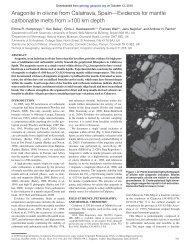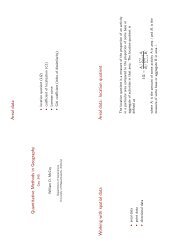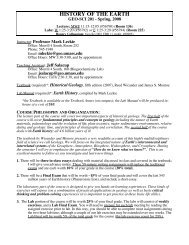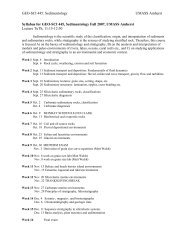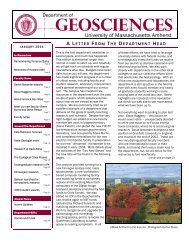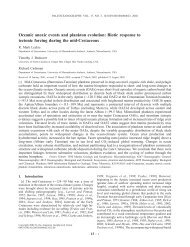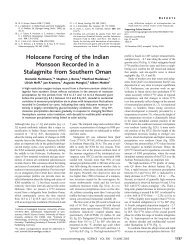Crystal Symmetry
Crystal Symmetry
Crystal Symmetry
Create successful ePaper yourself
Turn your PDF publications into a flip-book with our unique Google optimized e-Paper software.
<strong>Crystal</strong> <strong>Symmetry</strong><br />
The external shape of a crystal reflects the<br />
presence or absence of translation-free<br />
symmetry y elements in its unit cell.<br />
While not always immediately obvious, in<br />
most well formed crystal shapes, axis of<br />
rotation, , axis of rotoinversion, , center of<br />
symmetry, and mirror planes can be<br />
spotted.
All discussed d operations may be combined, but the<br />
number of (i.e. unique) combinations is limited,<br />
to 32. Each of these is known as a point group,<br />
or crystal class.<br />
The crystal classes may be sub-divided into one of<br />
6 crystal systems.<br />
Space groups are a combination of the 3D lattice<br />
Space groups are a combination of the 3D lattice<br />
types and the point groups (total of 65).
Each of the 32 crystal classes is unique to one<br />
of the 6 crystal systems:<br />
Triclinic, monoclinic, orthorhombic, tetragonal,<br />
hexagonal and isometric (cubic)<br />
Interestingly, while all mirror planes and poles<br />
of rotation must intersect at one point, this<br />
point may not be a center of symmetry (i).
<strong>Crystal</strong>lographic Axes<br />
The identification of specific symmetry operations<br />
enables one to orientate a crystal according to<br />
an imaginary set of reference lines known as the<br />
crystallographic axes.<br />
These are distinct and different from the classic<br />
Cartesian Axes, x, y and z, used in other<br />
common day usage, such as plotting graphs.
With the exception of the hexagonal system, the<br />
axes are designated a, a b, b and c. c<br />
The ends of each axes are designated + or -. This<br />
is important for the derivation of Miller Indices.<br />
The angles between the positive ends of the axes<br />
are designated α, β, and γ.<br />
α lies between b and c.<br />
β lies between a and c.<br />
γ lies between a and b.
Quantities can also be applied to further describe<br />
vectors and planes relative to a, b, and c<br />
These are u, v, w:<br />
u: projection along a<br />
v: projection along b<br />
w: projection along c
Quantities can also be applied to further describe<br />
vectors and planes relative to a, b, and c<br />
These are h, k, l:<br />
h: information relative to a axis<br />
v: information relative to b axis<br />
w: information relative to c axis<br />
[uvw] with (hkl)<br />
(hkl) faces on a cube
Axial Ratios<br />
With the exception of the cubic (isometric) system,<br />
there are crystallographic axes differing dff in length.<br />
Imagine one single unit cell and measuring the<br />
lengths of the a, b, and c axes.<br />
To obtain the axial ratios we normalise to the b axis.<br />
These ratios are relative.
Unique crystallographic axes of the 6<br />
crystal systems<br />
Triclinic: Three unequal axes with oblique angles.<br />
Monoclinic: Three unequal axes, two are inclined to<br />
one another, the third is perpendicular.<br />
Orthorhombic: Three mutually perpendicular axes of<br />
different lengths.<br />
Tetragonal: Three mutually perpendicular axes, two<br />
are equal, the third (vertical) is shorter.<br />
Hexagonal: Three equal horizontal axes (a 1 , a 2 , a 3 )<br />
and a 4 th perpendicular (vertical) of different length.<br />
Cubic: Three perpendicular axes of equal length.
Triclinic: Three unequal axes with oblique<br />
angles.<br />
• To orientate a triclinic crystal<br />
the most pronounced nced zone<br />
should be vertical.<br />
c<br />
• a and b are determined by<br />
the intersections of (010) and<br />
(100) with (001).<br />
<br />
<br />
<br />
b<br />
• The b axis should be longer<br />
than the a axis.<br />
a
The unique symmetry operation in a triclinic<br />
system is a 1-fold axis of rotoinversion(equivalent<br />
to a center of symmetry or inversion, i).<br />
All forms are pinacoids – therefore must consist of<br />
two identical and parallel faces.<br />
Common triclinic rock-forming minerals include<br />
microcline, some plagioclases, and wollastonite.
Monoclinic: Three unequal axes, two are<br />
inclined with oblique angles, the third is<br />
perpendicular.<br />
• Orientation ti of a crystal has<br />
few constraints – b is the<br />
only axis fixed by<br />
symmetry.<br />
• c is typically chosen on the<br />
basis of habit and<br />
cleavage.<br />
• α and γ = 90 °.<br />
• There are some very rare<br />
cases where b equals 90°<br />
giving a pseudo-<br />
orthorhombic form.<br />
a<br />
<br />
c<br />
<br />
<br />
b
The unique symmetry operation in a monoclinic<br />
system is 2/m – a twofold axis of rotation with a<br />
mirror plane.<br />
b is the rotation, while a and c lie in the mirror<br />
plane.<br />
Monoclinic crystals have two forms: pinacoids and<br />
prisms.<br />
Common monoclinic rock-forming minerals include<br />
clinopyroxene, mica, orthoclase and titanite.
Orthorhombic: Three mutually<br />
perpendicular axes of different<br />
lengths.<br />
• Convention has it that a crystal is<br />
oriented such that c > b > a.<br />
c<br />
• <strong>Crystal</strong>s are oriented so that c is<br />
parallel to crystal elongation.<br />
• In this case the length of the b axis<br />
is taken as unity and ratios are<br />
calculated thereafter.<br />
b<br />
<br />
<br />
<br />
a
The unique symmetry operation in an orthorhombic system is<br />
2/m 2/m 2/m – Three twofold axis of rotation coinciding with<br />
the three crystallographic axes.<br />
Perpendicular to each of the axes is a mirror plane.<br />
The general class for the orthorhombic system are rhombic<br />
dipyramid {hkl}.<br />
There are three types of form in the class: pinacoids, prisms,<br />
and dipyramids.<br />
Common orthorhombic rock-forming minerals include andalusite<br />
and sillimanite, orthopyroxene, olivine and topaz.
Tetragonal: Three mutually perpendicular<br />
axes, two are equal, the third (vertical) is<br />
shorter.<br />
• The two horizontal axis in a<br />
tetragronal mineral are oriented in<br />
the plane of the horizontal.<br />
Therefore, if a = b, c must be in<br />
the vertical. a 2<br />
c<br />
• There is no rule as to whether c is<br />
greater or less than a. a<br />
a 1
The unique symmetry operation in a tetragonal system is 4/m 2/m<br />
2/m – The vertical axis (c) is always a fourfold axis of rotation.<br />
There are 4 two-fold axis of rotation: 2 parallel to the<br />
crystallographic axes a and b, b the others at 45°<br />
.<br />
There are 5 mirror planes.<br />
The general class for the orthorhombic system is known as the<br />
ditetragonal-dipyramidal class.<br />
There are four types of form in the class: basal pinacoids,<br />
tetragonal prisms, tetragonal dipyramids, and ditetragonal<br />
prisms.<br />
Common tetragonal rock-forming minerals include zircon, rutile and<br />
anatase, and apophyllite.
Hexagonal: Three equal horizontal axes (a 1 , a 2 , a 3 )<br />
and a 4 th perpendicular vertical axis of different<br />
length.<br />
• The three horizontal axis of a<br />
hexagonal mineral are oriented in<br />
the plane of the horizontal, with c<br />
in the vertical.<br />
c<br />
• Unlike the other systems the<br />
Bravais-Miller nomenclature for<br />
crystal faces is given by 4 numbers<br />
(i.e. {0001})<br />
• The first three numbers are listed<br />
in order of a 1 , a 2 , a 3 .<br />
a 3<br />
a 2<br />
a 1<br />
90° = = 90°<br />
= 120°
The unique symmetry operation in the hexagonal system is a sixfold<br />
axis of rotation, and the most common space group is 6/m<br />
2/m 2/m.<br />
There vertical axis is the six-fold rotational operation, while there<br />
are a further 6 two-fold axis of rotation ti in the horizontal plane (3<br />
coincide with the a n axes).<br />
There are 7 mirror planes.<br />
The general class for the orthorhombic system is known as the<br />
dihexagonal-dipyramidal class.<br />
There are five types of form in the class: pinacoids, hexagonal<br />
prisms, hexagonal dipyramids, dihexagonal prisms, and<br />
dihexagonal dipyramids.<br />
Common hexagonal minerals include beryl and apatite.
Isometric (cubic): Three equal length axes that<br />
intersecting at right-angles to one another.<br />
• The axes are indistinguishable, as<br />
are the intersecting angles. As<br />
such all are interchangable.<br />
• There are 15 isometric forms, but<br />
a 3<br />
the most common are:<br />
a 2<br />
– Cube<br />
– Octahedron<br />
– Dodecahedron<br />
– Tetrahexahedron<br />
– Trapezohedron<br />
– Trisoctahedron<br />
– Hexoctahedron<br />
= = = 90°<br />
a 1




